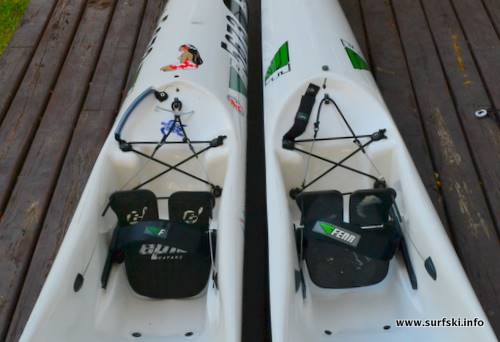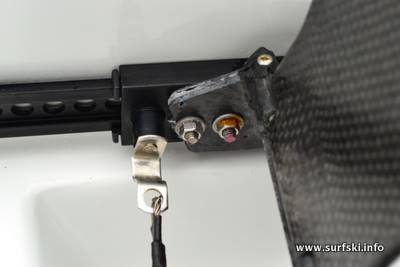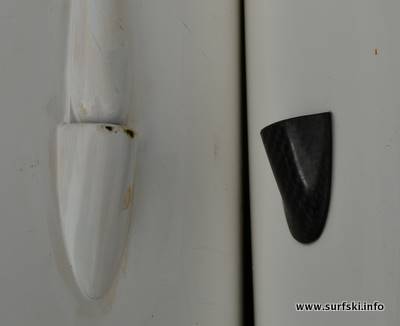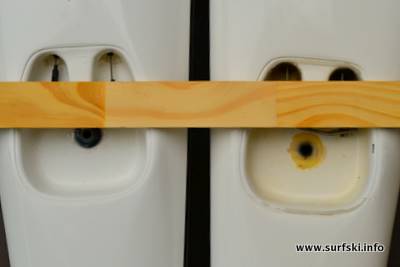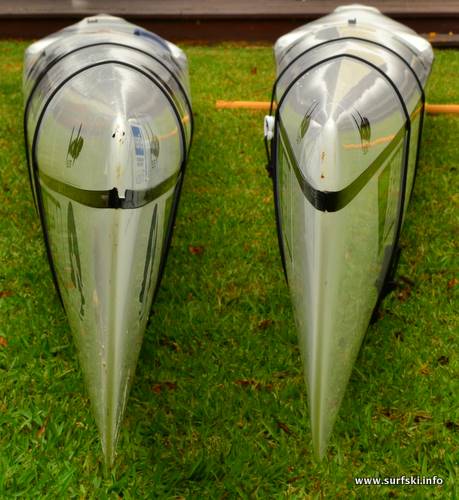Fenn Mako Elite Slim Line – First Looks
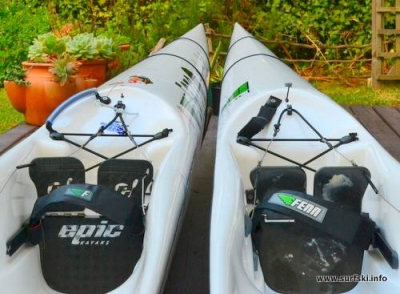 Mako Elite v Mako Elite SL
Credits: www.surfski.info
Mako Elite v Mako Elite SL
Credits: www.surfski.info
I had the good fortune to paddle the latest Fenn creation last weekend – the Mako Elite Slim Line (SL). I’d heard that the boat was tippier than the Elite and I was curious to see how I’d handle it.
Paddling the ski
I only had the opportunity to paddle the boat for a day, so I took it Hout Bay – one of my favorite testing grounds where the ocean swell rebounds off the steep rocky cliffs and creates a whole range of sea states. In places the confused chop tests your ability to stay upright, but if you’re awake, you find that you can catch runs in all directions – it’s a great place to paddle.
In the harbor I had the ski up to 15kph sustained (briefly!) which is fast for me. In the chop outside as we were paddling into the wind, I found to my surprise that although the ski is slightly tippier than the Elite, I found it quite manageable and was able to put the hammer down and accelerate away from my paddling buddy. The secondary stability is, in any case, very solid and I never felt as though I was going to come out of the boat.
After heading out for a couple of km into the light southeaster, we turned downwind, heading towards Seal Island. This area always offers something in the way of rides on the reflected swell bouncing off the bottom of Chapman’s Peak. To me it seemed as though the ski leapt onto the waves with alacrity.
It also seemed slightly more responsive to the rudder than the Elite.
Wake-riding
Reaching Seal Island, we noticed Nauticat - a big tourist catamaran - coming up behind us, so we paddled around the island, intending to catch her as she started back to Hout Bay Harbor.
Having rounded the island (paddling over a sleeping Dungeons Reef, famous for big wave surfing) I headed back over the kelp towards the channel – and hit 18.2kph riding a swell across the shallow water.
Perfect timing: Nauticat was leaving the island and I headed towards her, crossing her stern to catch the wake on her seaward side. What with the choppy sea swell running in from the right, it was a roller coaster ride; Nauticat travels at around 13kph, making it easy to stay on the wave. She also leaves a series of wake lines, so if you do broach off, you can easily recover and catch the next set. All in all, it’s not only great fun, but great practice for catching and staying on runs.
Dale had headed towards the bay to catch Nauticat in slightly calmer water – soon we were both on her wake, with Dale on the wave line in front of mine. He eventually broached and I had to pull off my wave too in order not to T-bone him. By then Nauticat was well into the bay, leaving a clean wake for hundreds of metres on either side. I crossed her stern again and caught up with the left hand wake 150m behind – and rode it all the way back to the harbor.
It seemed to me that the SL was very controllable – both in the roller coaster chop outside the bay and on the smooth, short wake on the flat water. I was able to slide diagonally down the wake, making my way back towards Nauticat.
Conclusions?
I have to say: the boat feels fast. Maybe that’s something to do with the slim nose or the lightness of the boat. I didn’t weigh it, but it’s somewhere around 12kg in the carbon layup that I paddled.
To tell for sure, I’d want to paddle it in a couple of races in order to compare it with my regular marks.
And the tippiness? Hout Bay is a good testing ground precisely because there’s always a lot of movement in the water. The ski seemed very handleable to me – but my personal bête noir conditions when it comes to tippy boats, is when I have to paddle across a strong wind in big waves…
Comfort
The boat is extraordinarily comfortable – for me. My backside is supremely compatible with Fenn skis – but this is not true for everyone.
Some hard facts
So much for feelings, what are the actual differences between the regular Mako Elite and the Slim Line?
I took the rudders off the boats and set them up, propping them up on two pieces of straight wood to even out the bumps on our deck.
the two skis are very similar in shape (SL below)
The cockpits are virtually identical - except for the changes noted below
Simple, sturdy footplate mechanism - no changes here.
The SL has a larger scupper than previous boats. It seems to work well but I prefer the bullet scuppers installed on my Elite, left.
Rocker
Without a dead flat surface, it’s very difficult to be certain – but I couldn’t find any appreciable difference between the two skis.
Rudder placement
The rudder on the SL is 10mm further forward than the Elite. This might explain the apparent increase in responsiveness that I felt on the water.
The rudder on the SL has moved 10mm forward
Hull Width
The Slim Line is, as its name suggests, appreciably narrower than the Elite – from the seat forward to the nose.
| Hull width at… | Elite | SL |
|---|---|---|
| …the catch (just aft of the bottle recess) | 345mm | 330mm |
| …the scuppers | 375mm | 365mm |
| …the seat | 430mm | 425mm |
The slimmed nose is evident - on the right if you're blind!
Volume
The SL’s nose is appreciably narrower than the Elite’s – but what about the volume? Without building a set of calipers I couldn’t measure the relative widths to any degree of accuracy due to the curvature of the foredeck. So I measured the circumference of the hull at set points instead.
| Position | Elite | SL | Difference |
|---|---|---|---|
| 50cm from the tail | 460mm | 465mm | +5mm |
| 100cm from the tail | 680mm | 690mm | +10mm |
| 150cm from the tail | 873mm | 883mm | +10mm |
| 80cm from the nose | 825mm | 825mm | 0mm |
| 140cm from the nose | 950mm | 940mm | -10mm |
| At the drain hole | 1067mm | 1062mm | -5mm |
Bearing in mind the tolerances of my wife’s sewing measuring tape, it appears that the SL has slightly greater volume behind the cockpit and slightly less in front. What does this mean? One might deduce that the ski will lift onto smaller runs more easily, but what happens when the narrower nose slices into the wave in front in bigger conditions? Conventional wisdom suggests that a wider nose (like that of the Red7 Surf 70 Pro) can be beneficial to prevent the nose dipping. Time will tell.
Seat and footwell
The seat depth in the two skis is identical – the maximum depth of the bucket being 205mm from the rails.
The hump between bucket and footwell has been lowered slightly – improving the comfort of the cockpit (and, presumably, the stability since lower legs means lower centre of gravity).
The bottom of the bucket has been narrowed slightly, which suits me, but it may be tight for paddlers with bigger backsides.
Race Results
The introduction of the ski was typically low-key – Hank McGregor, Jeremy Cotter and Hayden Smith paddled them at the Dubai Shamaal to absolutely no fanfare.
The disappointing results – McGregor and Cotter came sixth and eighth respectively had more to do with the line that the two men took, and they didn’t blame the ski. They paddled together, closer inshore than the lead group, and smacked into a strong current that took away any chance they had of dominating the race. Hayden Smith, on a similar inshore line was happy with his thirteenth position. He’d been training for the ultra long distance Southern Shamaal and had been focusing on endurance rather than speed. (A week later, paddling the SL again, he came second in the 250km Southern Shamaal.)
In conversation before the race, McGregor said that one of the things he enjoyed about the new ski was the narrowness of the cockpit at the catch. “I used to hit the Elite with my paddle,” he said. “That doesn’t happen at all now.”
Current Surfski World Champ Dawid Mocke hasn’t paddled his SL much, not wanting to upset his pre-Perth training. He’ll be spending more time in the boat on his return from Australia.
McGregor said the only question mark he had was how the ski will perform in big downwind conditions. (Mocke paddled the ski to a personal best on a Millers Run in Cape Town but felt he might have done an even faster time on his Elite.)
Clearly the jury is out on the ski’s performance in big downwind conditions.
As for me, I’m looking forward to trying my hand in the ski in a couple of races – and on a Millers Run or two! Right now though I don’t have access to one – so I’ll have to contain my impatience.



